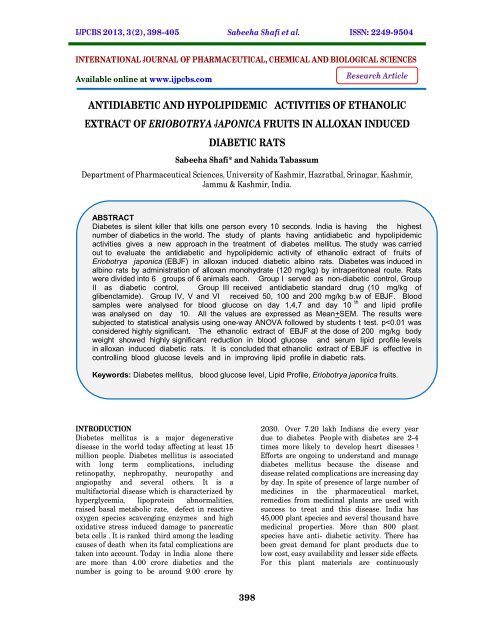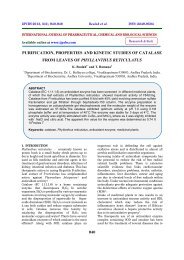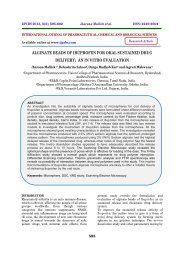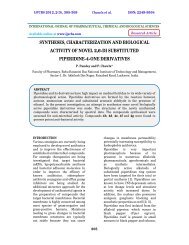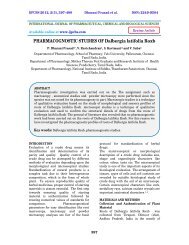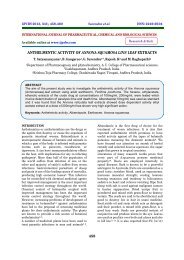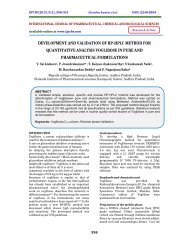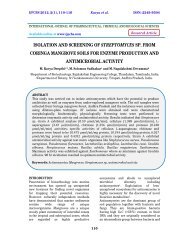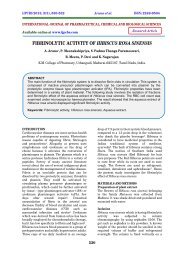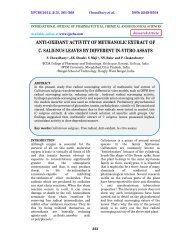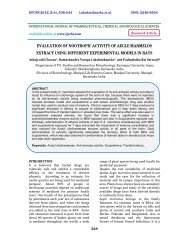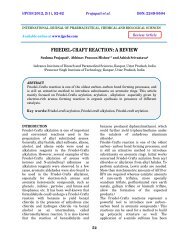antidiabetic and hypolipidemic activities of ethanolic extract ... - ijpcbs
antidiabetic and hypolipidemic activities of ethanolic extract ... - ijpcbs
antidiabetic and hypolipidemic activities of ethanolic extract ... - ijpcbs
You also want an ePaper? Increase the reach of your titles
YUMPU automatically turns print PDFs into web optimized ePapers that Google loves.
IJPCBS 2013, 3(2), 398-405 Sabeeha Shafi et al. ISSN: 2249-9504<br />
INTERNATIONAL JOURNAL OF PHARMACEUTICAL, CHEMICAL AND BIOLOGICAL SCIENCES<br />
Available online at www.<strong>ijpcbs</strong>.com<br />
Research Article<br />
ANTIDIABETIC AND HYPOLIPIDEMIC ACTIVITIES OF ETHANOLIC<br />
EXTRACT OF ERIOBOTRYA JAPONICA FRUITS IN ALLOXAN INDUCED<br />
DIABETIC RATS<br />
Sabeeha Shafi* <strong>and</strong> Nahida Tabassum<br />
Department <strong>of</strong> Pharmaceutical Sciences, University <strong>of</strong> Kashmir, Hazratbal, Srinagar, Kashmir,<br />
Jammu & Kashmir, India.<br />
ABSTRACT<br />
Diabetes is silent killer that kills one person every 10 seconds. India is having the highest<br />
number <strong>of</strong> diabetics in the world. The study <strong>of</strong> plants having <strong>antidiabetic</strong> <strong>and</strong> <strong>hypolipidemic</strong><br />
<strong>activities</strong> gives a new approach in the treatment <strong>of</strong> diabetes mellitus. The study was carried<br />
out to evaluate the <strong>antidiabetic</strong> <strong>and</strong> <strong>hypolipidemic</strong> activity <strong>of</strong> <strong>ethanolic</strong> <strong>extract</strong> <strong>of</strong> fruits <strong>of</strong><br />
Eriobotrya japonica (EBJF) in alloxan induced diabetic albino rats. Diabetes was induced in<br />
albino rats by administration <strong>of</strong> alloxan monohydrate (120 mg/kg) by intraperitoneal route. Rats<br />
were divided into 6 groups <strong>of</strong> 6 animals each. Group I served as non-diabetic control, Group<br />
II as diabetic control, Group III received <strong>antidiabetic</strong> st<strong>and</strong>ard drug (10 mg/kg <strong>of</strong><br />
glibenclamide). Group IV, V <strong>and</strong> VI received 50, 100 <strong>and</strong> 200 mg/kg b.w <strong>of</strong> EBJF. Blood<br />
samples were analysed for blood glucose on day 1,4,7 <strong>and</strong> day 10 th <strong>and</strong> lipid pr<strong>of</strong>ile<br />
was analysed on day 10. All the values are expressed as Mean+SEM. The results were<br />
subjected to statistical analysis using one-way ANOVA followed by students t test. p
IJPCBS 2013, 3(2), 398-405 Sabeeha Shafi et al. ISSN: 2249-9504<br />
scrutinized <strong>and</strong> explored for their effect as<br />
<strong>antidiabetic</strong> agents.<br />
One <strong>of</strong> the plants is Eriobotrya japonica locally<br />
known as loquat, has been used since olden<br />
times in the ethno medicine for treating<br />
diseases. The plant is reported to possess<br />
antioxidant 2,3,4 antiviral 5,6 cytotoxic 7<br />
hepatoprotective 8<br />
antiinflammatory/antitussive<br />
activity 9,10,11. There is<br />
dearth <strong>of</strong> reports on the <strong>antidiabetic</strong> <strong>and</strong><br />
<strong>hypolipidemic</strong> effects <strong>of</strong> the fruits <strong>of</strong> this plant.<br />
The present study was aimed to investigate<br />
<strong>antidiabetic</strong> <strong>and</strong> <strong>hypolipidemic</strong> activity <strong>of</strong><br />
<strong>ethanolic</strong> <strong>extract</strong> <strong>of</strong> Eriobotrya japonica fruit in<br />
alloxan induced diabetic rats.<br />
MATERIALS AND METHODS<br />
Plant Material<br />
The fruits <strong>of</strong> Eriobotrya japonica (family<br />
Rosaceae ) were collected from Shalimar area<br />
<strong>of</strong> the district, Srinagar, during the months <strong>of</strong><br />
April to June <strong>and</strong> authenticated by a plant<br />
taxonomist in the Centre <strong>of</strong> Plant Taxonomy,<br />
University <strong>of</strong> Kashmir, Srinagar. The<br />
identification was done on the basis <strong>of</strong> the<br />
characters described by Kirtikar <strong>and</strong> Basu,<br />
1935. A sample <strong>of</strong> the plant material was<br />
deposited in the herbarium <strong>of</strong> the Department<br />
<strong>of</strong> Taxonomy, University <strong>of</strong> Kashmir under<br />
voucher specimen number 1012(KASH) dated<br />
15-09-2008 for future reference. The plant<br />
material was dried in a well ventilated room<br />
with outside temperature ranging between<br />
18 to 32 0 C .<br />
Preparation <strong>of</strong> the <strong>extract</strong><br />
The fruits were coarsely powdered <strong>and</strong> 500<br />
gm <strong>of</strong> the material was allowed to macerate<br />
for 48 hrs with 50% ethanol, with occasional<br />
shaking. After 48 hrs, the <strong>ethanolic</strong> <strong>extract</strong><br />
was filtered through Whatmans filter paper.<br />
The plant material was then macerated again<br />
with fresh 50% ethanol <strong>and</strong> the filtrate<br />
obtained from the first <strong>and</strong> the second<br />
maceration was then combined <strong>and</strong> the<br />
solvent was recovered . After the recovery <strong>of</strong><br />
alcohol, the <strong>extract</strong> was then evaporated to<br />
dryness <strong>and</strong> the yield was noted.The <strong>extract</strong><br />
was refrigerated at 4 0 C for future use in<br />
experimental studies.<br />
Phytochemical Screening<br />
The <strong>extract</strong> obtained was subjected to<br />
qualitative tests for identification <strong>of</strong> different<br />
constituents like tannins, alkaloids, saponins,<br />
glycosides, terpenes, phenolics, flavonoids,<br />
carbohydrates, proteins <strong>and</strong> steroids, by using<br />
simple <strong>and</strong> st<strong>and</strong>ard qualitative methods<br />
described by Trease <strong>and</strong> Evans .12<br />
Pharmacological Study<br />
Animals<br />
Healthy albino rats <strong>of</strong> either sex weighing about<br />
180-210 g were used during the study. The<br />
animals were procured from Central Animal<br />
House, IIIM (Indian Institute <strong>of</strong> Integrative<br />
Medicine) Jammu <strong>and</strong> were housed in clean<br />
polypropylene cages. Before initiation <strong>of</strong><br />
experiment, the rats were acclimatized for a<br />
period <strong>of</strong> 7 days. St<strong>and</strong>ard environmental<br />
conditions such as temperature ranging from 18<br />
to 32 o C, relative humidity ( 70%) <strong>and</strong> 12 hrs<br />
dark/light cycle were maintained in the<br />
quarantine. All the animals were fed with rodent<br />
pellet diet ( Ashirwad Industries) <strong>and</strong> water<br />
ad-libitum under strict hygienic conditions. All<br />
procedures were performed in accordance to<br />
CPCSEA guidelines after approval from the<br />
Institutional Animal <strong>and</strong> Ethics Committee (<br />
IAEC) <strong>of</strong> the Department <strong>of</strong> Pharmaceutical<br />
Sciences, University <strong>of</strong> Kashmir[No. F-IAEC<br />
(Pharm.Sc) APPROVAL/2008/4 Dated Oct<br />
23 rd ,2008]<br />
Induction <strong>of</strong> diabetes<br />
Alloxan monohydrate was obtained from S.D<br />
Fine Chemical, Mumbai, India. All the other<br />
chemicals used were <strong>of</strong> analytical grade <strong>and</strong><br />
were acquired from commercial sources. A<br />
single dose (120mg/kg, b.w, i.p) <strong>of</strong> alloxan<br />
monohydrate in sterile saline was used for<br />
the induction <strong>of</strong> diabetes in rats after<br />
overnight fasting. After one hour <strong>of</strong> alloxan<br />
administration, the animals were fed st<strong>and</strong>ard<br />
pellets <strong>and</strong> water ad libitum. After 5 days <strong>of</strong><br />
alloxan administration, animals showing blood<br />
glucose levels above 250 mg/dl were selected<br />
for the study. Extract <strong>of</strong> EBJF was administered<br />
at three dose levels 50, 100 <strong>and</strong> 200 mg/kg 13<br />
Experimental design<br />
Rats fasted overnight for 12 hrs were<br />
r<strong>and</strong>omly divided into 6 groups <strong>of</strong> 6 rats per<br />
group.The various groups were:-<br />
Group I- Served as normal control <strong>and</strong> received<br />
only 0.2 ml <strong>of</strong> 2% aqueous gum acacia<br />
Group II- Served as diabetic control <strong>and</strong><br />
received only alloxan monohydrate <strong>and</strong> 2%<br />
aqueous gum acacia.<br />
Group III- Alloxan monohydrate + Glibenclamide<br />
(10 mg/kg, p.o) <strong>and</strong> served as St<strong>and</strong>ard<br />
Antidiabetic drug.<br />
Group IV- Alloxan monohydrate + 50%<br />
Ethanolic <strong>extract</strong> <strong>of</strong> EBJF (50 mg/kg, p.o)<br />
Group V- Alloxan monohydrate +50% Ethanolic<br />
<strong>extract</strong> <strong>of</strong> EBJF (100 mg/kg, p.o)<br />
Group VI- Alloxan monohydrate +50% Ethanolic<br />
<strong>extract</strong> <strong>of</strong> EBJF ( 200 mg/kg, p.o).<br />
399
IJPCBS 2013, 3(2), 398-405 Sabeeha Shafi et al. ISSN: 2249-9504<br />
The treatment (p.o) <strong>of</strong> the <strong>ethanolic</strong> <strong>extract</strong><br />
was started the same day except normal control<br />
<strong>and</strong> diabetic control groups which received only<br />
0.2 ml <strong>of</strong> 2% aqueous gum acacia for a period <strong>of</strong><br />
10 days. During this period, animals in all<br />
groups had free access to st<strong>and</strong>ard diet <strong>and</strong><br />
water. Body weight <strong>and</strong> blood glucose levels<br />
were estimated on 1 st , 4 th , 7 th <strong>and</strong> 10 th day <strong>of</strong><br />
the treatment.<br />
Sample Collection<br />
Blood samples were collected by pricking the<br />
tail from overnight fasted rats <strong>and</strong> blood<br />
glucose levels were estimated using One Touch<br />
Ultra glucose strips ( Johnson & Johnson Ltd)<br />
on 1 st , 4 th , <strong>and</strong> 7 th day.<br />
Estimation <strong>of</strong> biochemical parameters<br />
On day 10 th , blood was collected from overnight<br />
fasted rats under ether anesthesia by cardiac<br />
puncture <strong>and</strong> was kept aside for 30 min for<br />
clotting. By centrifuging the same sample at<br />
6000 rpm for 20 min, the serum was separated<br />
<strong>and</strong> was analyzed for blood glucose [14], total<br />
cholesterol [15], triglycerides [16],<br />
HDL<br />
cholesterol [17] <strong>and</strong> LDL cholesterol . [18]<br />
Statistical analysis<br />
All the values are expressed as mean+SEM. The<br />
results were subjected to statistical analysis<br />
using one-way ANOVA followed by students t<br />
test.p
IJPCBS 2013, 3(2), 398-405 Sabeeha Shafi et al. ISSN: 2249-9504<br />
The literature reports reveal that flavonoids <strong>and</strong><br />
tannins present in the plant <strong>extract</strong> known to<br />
possess antihyperglycemic <strong>and</strong> <strong>hypolipidemic</strong><br />
activity. In the present investigation also the<br />
observed antihyperglycemic <strong>and</strong> <strong>hypolipidemic</strong><br />
potential <strong>of</strong> test <strong>extract</strong> may be due to presence<br />
<strong>of</strong> similar phytoconstituents which was evident<br />
by preliminary phytochemical screening. Since<br />
many antihyperglycemic drugs do not correct<br />
dyslipidemia, the observed <strong>hypolipidemic</strong><br />
effects <strong>of</strong> the plant <strong>extract</strong> in diabetic rats<br />
makes EBJF quite important in the<br />
management <strong>of</strong> diabetes.Since there is a strong<br />
well-established link between diabetes<br />
mellitus, dyslipidemia, obesity, hypertension<br />
<strong>and</strong> ischemic heart disease, effect <strong>of</strong> the plant<br />
<strong>extract</strong> on weight loss/gain needs to be<br />
explored on scientific base.<br />
Table 1: Phytochemical Results <strong>of</strong><br />
Eriobotrya japonica fruits<br />
S.No Phytoconstituents Results<br />
1 Tannins _<br />
2 Alkaloids +<br />
3 Saponins _<br />
4 Glycosides +<br />
5 Terpenes _<br />
6 Phenolics _<br />
7 Flavonoids +<br />
8 Carbohydrates +<br />
9 Proteins _<br />
10 Steroids _<br />
Table 2: Effect <strong>of</strong> 50% <strong>ethanolic</strong> <strong>extract</strong> <strong>of</strong> Eriobotrya japonica (EBJF) fruits on fasting blood<br />
glucose level (mg/dl) in alloxan induced diabetic rats<br />
Group Treatment<br />
1 st day 4 th day 7 th day 10 th day<br />
I<br />
Normal control 0.2 ml <strong>of</strong> 2% aqueous<br />
85.07± 4.35 86.16±4.43 84.82±5.96 84.71±6.11<br />
Gum acacia<br />
II<br />
Diabetic control (Vehicle)<br />
0.2 ml <strong>of</strong> 2% aqueous gum acacia 261.47±8.37 264.28±8.29 268.03±8.48 271.33±8.18***<br />
III<br />
Alloxan monohydrate + glibenclamide<br />
(10 mg/kg) 200.37±5.25 141.18±2.43 124.52±2.00 114.84±3.21***<br />
IV<br />
Alloxan monohydrate+ 50% Ethanolic <strong>extract</strong><br />
(EBJF,50 mg/kg) 201.17±4.85 159.48±2.68 158.76±2.81 157.04±3.09***<br />
V<br />
Alloxan monohydrate+<br />
50% Ethanolic <strong>extract</strong>(EBJF,100 mg/kg) 201.17±4.85 146.43±2.46 135.44±2.72 128.64±1.61***<br />
VI<br />
Alloxan monohydrate + 50% Ethanolic<br />
<strong>extract</strong>(EBJF,200 mg/kg) 204.27±4.25 144.65±1.53 118.35±3.42 82.82±5.53***<br />
Animal: Albino Rats<br />
Alloxan: 120 mg/kg.i.p<br />
Extract: p.o.<br />
Values are Mean ±S.E.M n=6; except in Group V where n=5<br />
***P< 0.01 highly significant<br />
Groups III,IV,V,VI vs Diabetic Control ( Group II) <strong>and</strong> Group I vs Group II on 10 th day<br />
Fig. 1: Effect <strong>of</strong> 50% <strong>ethanolic</strong> <strong>extract</strong> <strong>of</strong> Eriobotrya japonica (EBJF)<br />
fruits on fasting blood glucose level (mg/dl) in alloxan induced<br />
diabetic rats after 10 days <strong>of</strong> dosing.Each bar represents the mean ± SEM<br />
401
IJPCBS 2013, 3(2), 398-405 Sabeeha Shafi et al. ISSN: 2249-9504<br />
Table 3: Effect <strong>of</strong> 50% <strong>ethanolic</strong> <strong>extract</strong> <strong>of</strong> Eriobotrya japonica fruits on lipid pr<strong>of</strong>ile in alloxan<br />
induced diabetic rats<br />
Grou<br />
P<br />
Treatment<br />
Serum total<br />
Cholesterol<br />
mg/dl<br />
Serum<br />
triglyceride<br />
mg/dl<br />
Serum HDL<br />
Cholesterol<br />
mg/dl<br />
Serum LDL<br />
Cholesterol<br />
mg/dl<br />
I Normal control 0.2 ml <strong>of</strong> 2%<br />
aqueous gum acacia 85.25±8.51 80.71±9.38 24.54±6.49 52.03±3.21<br />
II Diabetic control 0.2 ml <strong>of</strong> 2%<br />
aqueous gum acacia 218.15±23.79 194.56±14.99 21.11±1.45 89.59±13.82<br />
III (Alloxan monohydrate<br />
+st<strong>and</strong>ard drug glibenclamide 206.35±6.11* 184.30±9.68* 29.03±3.16* 85.39±7.24*<br />
10 mg/kg)<br />
IV Alloxan monohydrate<br />
+ Ethanolic <strong>extract</strong><br />
(EBJF,50 mg/kg)<br />
159.4±13.65** 158.53±13.66** 29.94±4.92* 103.21±10.67**<br />
Alloxan monohydrate<br />
V +Ethanolic <strong>extract</strong> (EBJF,100<br />
mg/kg)<br />
VI Alloxan monohydrate<br />
+Ethanolic <strong>extract</strong> (EBJF,200<br />
mg/kg)<br />
Animal: Albino Rats<br />
133.17±19.41** 111.21±12.52**<br />
*<br />
Extract: p.o.<br />
Value are Mean ±S.E.M: n=6 except in Group V where n =5<br />
* p> 0.05 non significant<br />
**p< 0.05 significant<br />
***P< 0.01 highly significant;<br />
Groups III,IV,V,VI vs Diabetic Control ( Group II) <strong>and</strong> Group I vs Group II on 10 th day<br />
30.54±3.23* 60.54±4.99**<br />
98.15±4.78*** 86.13±11.49*** 32.73±4.04* 60.78±6.68**<br />
Alloxan: 120 mg/kg.i.p<br />
Fig. 2: Effect <strong>of</strong> 50% <strong>ethanolic</strong> <strong>extract</strong> <strong>of</strong> Eriobotrya japonica fruits on lipid pr<strong>of</strong>ile in alloxan<br />
induced diabetic rats after 10 days <strong>of</strong> dosing. Each data column represents the mean ± SEM<br />
402
IJPCBS 2013, 3(2), 398-405 Sabeeha Shafi et al. ISSN: 2249-9504<br />
Table 4: Effect <strong>of</strong> 50% <strong>ethanolic</strong> <strong>extract</strong> <strong>of</strong> Eriobotrya japonica (EBJF) fruits on average body<br />
weight ( g ) in alloxan induced diabetic rats<br />
Group Treatment Average Body weight <strong>of</strong> the animal (g)<br />
1 st day 4 th day 7 th day 10 th day<br />
I<br />
Normal control<br />
0.2 ml <strong>of</strong> 2% aqueous 228.85±6.03 229.88±6.66 233.00±7.07 222.05±4.75<br />
gum acacia<br />
II Diabetic control 0.2 ml<br />
<strong>of</strong> 2% aqueous gum 180.58±3.66 163.86±2.08 152.21±3.12 124.76±2.35<br />
acacia<br />
III Alloxan monohydrate+<br />
st<strong>and</strong>ard drug<br />
glibenclamide<br />
183.83±3.34 173.85±3.37 152.98±4.44 137.50±3.54***<br />
( 10 mg/kg)<br />
IV Alloxan monohydrate +<br />
Ethanolic <strong>extract</strong><br />
180.53±2.83 177.23±1.64 171.36±2.73 171.47±2.74***<br />
(EBJF,50 mg/kg)<br />
V Alloxan monohydrate +<br />
Ethanolic <strong>extract</strong><br />
188.58±3.74 185.48±3.24 179.58±3.41 172.62±4.05***<br />
(EBJF,100 mg/kg)<br />
VI Alloxan monohydrate +<br />
Ethanolic <strong>extract</strong><br />
193.88±3.36 184.54±4.32 176.42±3.71 176.41±3.52***<br />
(EBJF,200 mg/kg)<br />
Animal: Albino Rats<br />
Alloxan: 120 mg/kg.i.p<br />
Extract: p.o.<br />
Value are Mean ±S.E.M: n=6 except in Group V where n =5<br />
* p> 0.05 non significant<br />
**p< 0.05 significant<br />
***P< 0.01 highly significant;<br />
Groups III,IV,V,VI vs Diabetic Control ( Group II) <strong>and</strong> Group I vs Group II on 10 th day<br />
Fig. 3: Effect <strong>of</strong> 50% <strong>ethanolic</strong> <strong>extract</strong> <strong>of</strong> Eriobotrya japonica fruits on Average<br />
Body Weight (g) in alloxan induced diabetic rats after 10 days <strong>of</strong> dosing.<br />
Each data column represents the mean ± SEM<br />
403
IJPCBS 2013, 3(2), 398-405 Sabeeha Shafi et al. ISSN: 2249-9504<br />
CONCLUSION<br />
From the study, it can be concluded that the<br />
50% <strong>ethanolic</strong> <strong>extract</strong> <strong>of</strong> Eriobotrya japonica<br />
fruit has beneficial effects on blood glucose<br />
levels as well as improving hyperlipidemia <strong>and</strong><br />
other metabolic aberrations. Further<br />
pharmacological <strong>and</strong> biochemical investigations<br />
will clearly elucidate the mechanism <strong>of</strong> action<br />
<strong>and</strong> will be helpful in projecting this plant as an<br />
therapeutic target in diabetics research.<br />
ACKNOWLEDGEMENT<br />
We are highly thankful to Sri Krishna Drugs Ltd.,<br />
C-4 Industrial Area Uppal, Hyderabad for<br />
providing a free gift pure sample <strong>of</strong><br />
Glibenclamide which was used as st<strong>and</strong>ard anti<br />
diabetic drug <strong>and</strong> also to University Grants<br />
Commission for financial assistance. The<br />
facilities provided by the Department <strong>of</strong><br />
Pharmaceutical Sciences University <strong>of</strong> Kashmir<br />
for carrying out this work also need<br />
appreciation.<br />
REFERENCES<br />
1. Alberti KG, Zimmet PZ. Definition<br />
diagnosis <strong>and</strong> classification <strong>of</strong> diabetes<br />
mellitus <strong>and</strong> its complications. Part I:<br />
Diagnosis <strong>and</strong> classification <strong>of</strong> diabetes<br />
mellitus, provisional report <strong>of</strong> a WHO<br />
consultation. Diab Med 1998; 15: 539-<br />
553.<br />
2. Hamada A, Yoshioka S, Takuma D,<br />
Yokota J, Cui T, Kusunose M, et al . The<br />
effect <strong>of</strong> Eriobotrya japonica seed<br />
<strong>extract</strong> on oxidative stress in<br />
adriamycin-induced nephropathy in<br />
rats. Biol <strong>and</strong> Pharm Bull 2004; 27:<br />
1961-1964.<br />
3. Huang Y, Li J, Cao Q, Yu SC, Lv XW, Jin Y,<br />
et al. Anti-Oxidative effect <strong>of</strong> triterpene<br />
acids <strong>of</strong> Eriobotrya japonica (Thumb)<br />
Lindl Leaf in chronic bronchitis rats.<br />
Life Science 2006; 78:2749-2757.<br />
4. Yokoto J, Takuma D, Hamada A,<br />
Onogawa M, Yoshioka S, Kusenose M, et<br />
al Scavenging <strong>of</strong> reactive oxygen<br />
species by Eriobotrya Japonica seed<br />
<strong>extract</strong>. Biol <strong>and</strong> Pharm Bull 2006; 29:<br />
467-471.<br />
5. Know HK, Kang MJ, Kim HJ, Choi JS,<br />
Paik KJ, Chung HY.Inhibition <strong>of</strong> NF<br />
kappaB by methyl chlorogenate from<br />
Eriobotrya japonica. Molecules <strong>and</strong><br />
Cells 2000; 10: 241-246.<br />
6. Baljinder S, Seena G, Dharmeadra K,<br />
Vikas G, Bansal P. Pharmacological<br />
Potential <strong>of</strong> Eriobotrya japonica- An<br />
overview. Int Res J <strong>of</strong> Pharm 2010; 1:<br />
95-99.<br />
7. Ito H, Kobayashi E, Takamasto Y, Li SH,<br />
Hatano T, Sakagami H, et al .<br />
Polyphenols from Eriobotrya japonica<br />
<strong>and</strong> their cytotoxicity against human<br />
oral tumour cell lines. Chem Pharm Bull<br />
2000; 48(5): 687-693.<br />
8. Nishioka Y, Yoshioka S, Kusunose M, Cui<br />
T, Hamada A, Ono M, et al. Effects <strong>of</strong><br />
<strong>extract</strong>s derived from Eriobotrya<br />
japonica on liver function improvement<br />
in rat. Biol <strong>and</strong> Pharm Bull 2002 ; 25 :<br />
1053-1057.<br />
9. Shimizu M, Fukumura H, Tsuji H,<br />
Tanaami S, Hayashi T, Morita N. Antiinflammatory<br />
constituents <strong>of</strong> topically<br />
applied crude drugs constituents <strong>and</strong><br />
anti-inflammatory effect <strong>of</strong> Eriobotrya<br />
japonica Lindl Chem <strong>and</strong> Pharm Bull<br />
1986; 34: 2614-2617.<br />
10. Ju JH, Zhou L, Lin G, Liu D, Wang LW,<br />
Yang JS. Studies on constituents <strong>of</strong><br />
triterpene acids from Eriobotrya<br />
Japonica <strong>and</strong> their anti-inflammatory<br />
<strong>and</strong> anti-tussive effects. J <strong>of</strong> Chinese<br />
Pharmacol 2003; 38: 752-757.<br />
11. Banno N, Akihisa T, Tokuda H,<br />
Yasukawa K, Taguchi Y, Akazawa H, et<br />
al.Anti inflammatory <strong>and</strong> antitumorpromoting<br />
effects <strong>of</strong> the triterpene<br />
acids from the leaves <strong>of</strong> Eriobotrya<br />
japonica. Biol <strong>and</strong> Pharm Bull 2005; 28:<br />
1995-1999.<br />
12. Rafia Rasool, Bashir A Ganai, Seema<br />
Akbar, Azra Kamili, et al. Phytochemical<br />
screening <strong>of</strong> Prunella vulgaris L An<br />
important Medicinal Plant <strong>of</strong> Kashmir.<br />
Pak J <strong>of</strong> Pharm Sci 2010; 23(4): 399-<br />
402.<br />
13. Vivek SK , Suresh K , Hitesh JP,<br />
Shivkumar Hypoglycaemic activity <strong>of</strong><br />
Ficus glomerata in alloxan induced<br />
diabetic rats. 2010; 1(2), 18-22<br />
14. Trinder P. Glucose oxidase method.<br />
Ann Clin Biochem 1969; 6.<br />
15. Allain CC, Poon LS, Chan CS, Richmond<br />
W, Fu PC. CHOD-PAP method for<br />
determination <strong>of</strong> total cholesterol. Clin<br />
Chem 1974; 20: 470-475.<br />
16. Mcgowan MW, Joseph DA, Str<strong>and</strong>bergh<br />
DR, Zak B. A Peroxidase coupled<br />
method for the colorimetric<br />
determination <strong>of</strong> serum triglyceride.<br />
Clin Chem 1983; 29:538-542.<br />
17. Fringe CS, Feridley TW, Dunn RT, Owan<br />
CA . Improved determination <strong>of</strong> total<br />
serum lipids by sulphosphovanillin<br />
reaction. Clin Chem 1972; 18: 673-674<br />
18. Friedewald WT, Levy RI, Frednickson<br />
DS. Estimation <strong>of</strong> the concentration <strong>of</strong><br />
404
IJPCBS 2013, 3(2), 398-405 Sabeeha Shafi et al. ISSN: 2249-9504<br />
low density lipoprotein cholesterol in<br />
Plasma, without use <strong>of</strong> the preparative<br />
ultra centrifuge. Clin Chem 1972; 18:<br />
499-502.<br />
19. Szkudelski T . The mechanism <strong>of</strong><br />
alloxan <strong>and</strong> streptozotocin action in<br />
beta cells <strong>of</strong> the rat pancreas. Physiol<br />
Res 2001; 50: 536-546.<br />
20. Lenzen S, Pantenu . Alloxan: history <strong>and</strong><br />
mechanism <strong>of</strong> action. Diabetologia<br />
1988; 31: 337-342.<br />
405


